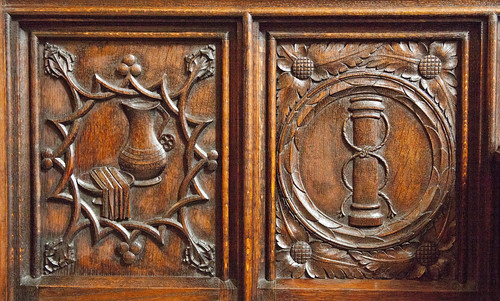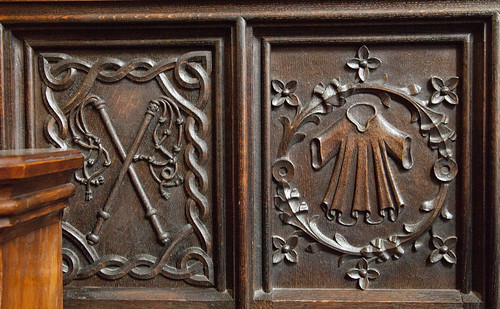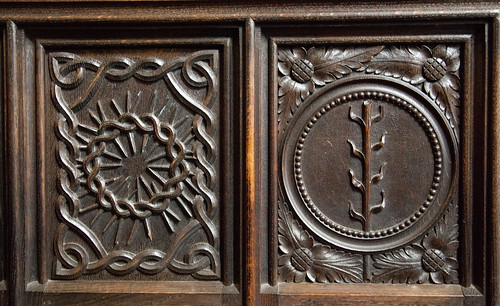 |
| Pilate washes his hands; the pillar of the flagellation. |
1: Leon Podles' argument about masculinity.
2: How Podles thinks the Church became feminised in the High Middle Ages
3. Doubts about Podles' historical argument.
4. The role of Rationalism and Romanticism in confirming the feminine image of the Church.
5. The liturgy, and a solution to the problem.
In the first post of this series I presented Podles' very simple understanding of what masculinity is. Since men don't give birth, it is a biological and cultural imperative that they be stimulated to face other kinds of dangers for the good of the community, the kinds of dangers, in fact, for which their physique and psychology fits them. I think this is pretty difficult to dispute, even if some people won't like it. But it means that there is a ineradicable idea of masculinity as achieved and not as given, the importance of which means that men must in some sense distance themselves from the feminine realm. The molly-coddled male has not achieved masculinity: he hasn't made it as a man. And he is unlikely to achieve much of value for the community.
It should be noted that the masculine has a 'parabolic trajectory': having separated himself from the feminine, the man can return to it, in some sense, making connection with the feminine in romantic love and family life. But he remains distinct from it, and remains in danger of losing his masculinity if he loses this distinctness in uxoriousness.
Note that this is not about homosexuality. The relationship of this issue with homosexuality is complex and controversial, and Podles doesn't have a great deal to say about it; nor will I.
Podles next big argument is that Western Christianity has become feminised, and that men no more want to stick around in church than they would want to stick around at a hen night. Sticking around in a feminised environment is a danger to a man's masculinity, which is something which cannot be taken for granted, particularly by adolescents and young men. This need not be articulated, though it often is, typically by men thinking or saying that church is for wimps and losers.
Podles can appeal to very unambiguous data about church participation rates, broken down by sex, for the the most recent few decades, and he extrapolates this into the past with anecdotal evidence. The problem has been been noticed by lots of people, but they tend to assume that it is characteristic of religion as a whole, or else as specific to the period or place they are studying (such as 19th century American Revivalism). Podles points out, however, that Eastern Christianity, Judaism and Islam do not have this problem. Even more surprisingly, while he claims that there is no evidence that it was a problem in the West in antiquity or the early Middle Ages, it is not limited to recent times, or America. Podles' argument is that something happened in the High Middle Ages, something which has stayed with us, more or less, ever since. He identifies three factors.
 |
| The scourges; the purple garment. |
2. Aristotelianism. Aristotle's metaphysical system of form and matter identifies the female with the material, and the male with the formal. The feminine tends, then, to be associated with the passive and receptive; the male with active and the giving of form or structure. In the spiritual realm, it is easy to see how this combines with bridal mysticism to suggest that because Christians should be receptive to God's grace and to God's re-forming of them, that means they need to be passive and in that sense feminine. Podles points out that this causes problems for both sexes. Passivity, he points out, is not the central feminine trait: rather, that is connected with the bonds of community. Our Lady's response to the Annunciation was not to lapse into passivity, but to get onto a donkey and make a long and potentially dangerous journey to reinforce the bonds linking her and her unborn Child with St Elizabeth and the unborn St John the Baptist.
3. Scholasticism. Podles notes the beginning of the separation of dogmatic theology from spirituality which begins to manifest itself with Scholasticism, and the super-rationalism of the schools. The problem is that spirituality began to be identified with feeling, and the 'science of theology' with rationality. The contrast has been manifested in different ways over the centuries, and now the whole of religion is often identified with emotional commitment rather than propositional belief. Men are less comfortable with the expression of emotion than women; the idea of religion in general or the spiritual life in particular as something demanding the expression of emotion is deeply off-putting to men.
I have reservations about Podles' analysis. While the issue of Bridal Mysticism, coupled with an Aristotelian analysis of sexuality, is very interesting, I am dubious about how damagingly influential these ideas were in the late Middle Ages and the Early Modern period. The conception of the feminine in Catholic culture outside a devotional context, certainly, does not reflect Podles' fears. Think of Shakespeare (or classical Spanish drama): the females are certainly feminine, but passive? You must be joking.
I'm also doubtful that the separation of reason and emotion can be laid at the door of the Scholastics, and even more that the late Middle Ages was a period in which men were being driven out of the Church en masse. For this period Podles' anecdotal evidence consists of remarks by preachers to the effect that 'women go more willingly to Church', and things like the reluctance of St Dominic to allow his friars to have all their time taken up with the spiritual direction of nuns. It doesn't amount to all that much.
As far as the Podles' causal factors go, I would want to make a number of distinctions. But this is something for another post.
 |
| The Crown of Thorns; the staff given the Christ as a mocking sceptre. |
I must say I rather doubt all of this. Perhaps the danger of feminisation does back to these causes and the danger has always been there. However in my experience, as someone brought up before Vatican II, feminisation has only run riot since Vatican II. Why? Religion is presented as all touchy feely - faith but no reason.
ReplyDeleteI am very inclined to agree. My only hesitation is the evidence he produces for feminisation in 19th France and in traditional Latin culture. See the next two posts.
DeleteTo be fair, if we're going to spread blame around I think we should Include St Theresa of Jesus and St John of the Cross, St Margaret Mary, St Alphonsus etc etc
ReplyDeleteI am glad you have brought this subject, an “unmentionable”, into the open. It is not before time.
ReplyDeleteSo far I have read only Podles’ introduction and that certainly makes you
think, but I won’t say more at this stage.
I think Nicolas is correct in saying the problem has run riot since Vat II. The large Jesuit parish I grew up in was quite masculine, with a good balance. My present parish is now quite feminised with a near complete lack of young males. The recent admittance of altar girls could well be the final straw as can be seen in the awkward embarrassed body language of the few remaining boys.
I keep coming back to my gut feeling that the success the reformers have had in changing the New Mass into a hymn singing protestant communion service has both driven away any remaining testosterone-normal but thinking youth, and eviscerated any earlier understanding of masculine Catholicism, that of Chesterton and Belloc.
Mind you, we now have Voris!
I wonder if the increased Marian devotion of the high Middle Ages distinguishes the bridal mysticism from the same analogy which was presented in Scriptural commentaries in the patristic period, such of that of Origen on the Song of Songs.
ReplyDelete